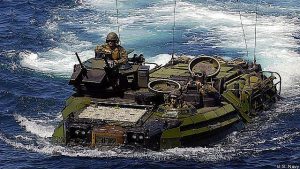
I. Immersion or submersion
II. Fording
Effects of immersion include:
- Fouling of lubricants between moving parts.
- Formation of electrically conductive paths which may cause electrical or electronic equipment to malfunction or become unsafe to operate.
- Corrosion due to direct exposure to the water or to the relatively high humidity levels caused by the water.
- Impairment of the burning qualities of explosives, propellants, fuels, etc.
- Failure of vehicle engines to operate.
For the Immersion test (Procedure I), the item is submerged so the top of the item is 1M below the surface. If the environment anticipates a deeper depth, it may be necessary to use a chamber and pressurize to the test depth, assuring the top of the test item is fully submerged. The Fording test (Procedure II) is primarily targeted at vehicles traversing a body of water or material secured to such vehicles. One facet of the Immersion test to consider is the item under test should be heated 27 deg C above the water temperature. When the item is submerged in the cooler water, it will cool down and the inside pressure will be lower. This may “suck” water into the item. 27 Deg C is specified to simulate solar heating. Otherwise, use 10 deg C as a differential to simulate normal differences between material and water temperature. The Immersion test should last approximately 30 minutes. The Fording test should last an hour. Prior to testing, doors, valves, etc., should be exercised a minimum of 3 times to assure seals are not sticking to the surfaces. After the test, examine the article for leaks. Air bubbles during the test are a good indication of a leak. Weight before and after the test may be a good indication of a leak. As a side note, the immersion test may be used for the rain test. However, rain dynamics can sometimes compromise seals so both rain and immersion tests should be conducted.
